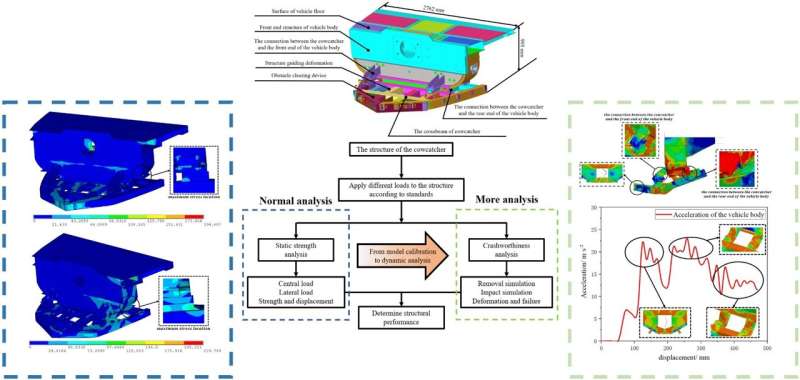This article has been reviewed according to Science X's editorial process and policies. Editors have highlighted the following attributes while ensuring the content's credibility:
fact-checked
proofread
Static strength, crashworthiness analysis of a train cowcatcher at high running speed

The cowcatcher is a unique device located at the front end of rail vehicles. It is generally installed at the bottom frame of the head car and can remove obstacles by colliding with foreign objects on the track ahead of the vehicle. This ensures the safety of the train and the prevention of major safety accidents such as derailment.
The current design of multi-unit cowcatchers primarily emphasizes efficient obstacle-removal capabilities. However, there is a need for additional research to explore the crashworthiness aspect, specifically the orderly deformation under collision.
In a new study published in the journal High-speed Railway, a team of researchers in China has reported the development of a finite element model to analyze structural static loads and collisions according to the EN 15227 standard. The prototype used for this study was a cowcatcher designed for a train traveling at a speed of 160 km/h.
"This type of cowcatcher has good obstacle clearance ability. When removing small mass obstacles, the obstacles can be directly ejected, and the cowcatcher will not produce significant plastic deformation," said Yanzhao Guo, lead author of the study.
"When removing large obstacles, the obstacles will be pushed forward for some distance, during which the tip of the cowcatcher will be crushed and there is a risk of fracture at both the front and rear connections to the vehicle body, with the latter being more vulnerable to damage."
The simulation results of the frontal collision of cowcatcher utilize the waist-shaped orifice plate structure to achieve energy absorption and deformation guidance functions, and it has a certain buffering ability. In practice, it can become a component of the energy absorption process of orderly deformation in head car collisions.
"Nonetheless, further optimization needs to be carried out, and the specific effect needs to be demonstrated through experiments," added Guo.
More information: Yanzhao Guo et al, Static strength and crashworthiness analysis of a train cowcatcher at a running speed of 160 km/h, High-speed Railway (2023). DOI: 10.1016/j.hspr.2023.11.004


















